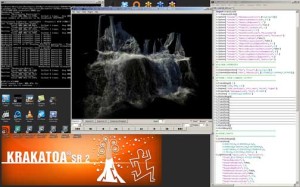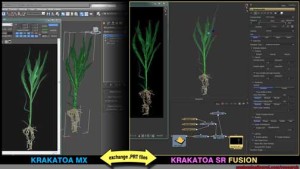
Thinkbox Software announced the release of Krakatoa SR, a stand-alone version of the company’s high-volume particle renderer for Microsoft Windows and Linux operating systems that can be integrated with any 3D content creation application.
Previously available for Autodesk 3ds Max and Autodesk Maya 3D software, Krakatoa is CPU-based, highly optimized, heavily multi-threaded, and can be used on most hardware running Windows or Linux operating systems, including laptops and render nodes, without dedicated high-end graphics accelerators. Krakatoa SR exposes both a Python-based interface and a C++ API to connect to various professional 3D applications such as The Foundry’s Nuke or Side Effects Software’s Houdini.
“We want artists to be able to deploy our tools in any way they can possibly imagine,” said Chris Bond, founder, Thinkbox Software. “Krakatoa SR enables even more applications to leverage our software’s powerful volumetric particle rendering capabilities and we’re eager to see what our clients produce once they start adopting it.”
 “Integrating Krakatoa SR with our existing toolset was easy and we were able to get it rolling without much effort,” said Arun Ramasamy, software engineer, Anatomical Travelogue. “We received constant support from the Thinkbox development team and it worked so well that we are developing Krakatoa into a functional particle rendering pipeline inside eyeon Software’s Fusion.”
“Integrating Krakatoa SR with our existing toolset was easy and we were able to get it rolling without much effort,” said Arun Ramasamy, software engineer, Anatomical Travelogue. “We received constant support from the Thinkbox development team and it worked so well that we are developing Krakatoa into a functional particle rendering pipeline inside eyeon Software’s Fusion.”
Haggi Krey, visual effects supervisor at Ambient Entertainment, has been using Krakatoa SR for work on the upcoming animated film Tarzan, which is scheduled for release in 3D later in 2013.
“When we switched our fluid pipeline to Naiad for Tarzan, we had been searching for a way to do high quality particle rendering and were extremely excited to get our hands on Krakatoa SR,” Haggi explained. “We were able to implement Krakatoa SR based on the open source OpenMaya framework and Partio library, and now we can read any particle system from almost any software and render in Krakatoa. Without Krakatoa, it would be impossible to get the required quality on some of our shots.”
Krakatoa SR is compatible with the network rendering licenses used by the other Krakatoa implementations, (Krakatoa MX and Krakatoa MY).





